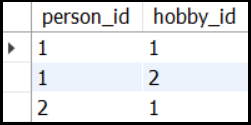Contents [hide]
Many to Many Mapping
Many To Many mapping to represent a many to many relationships between tables. A many to many relationships occurs when many records from one table correspond to many records from another table.
For example, many persons can have many hobbies and a hobby can belong to many persons. So many records from the person table can correspond to many records from the hobby table.

Tools and Technologies Used:
1. Java 8
2. MySQL 8
3. Eclipse IDE
4. mysql-connector-java-8.0.23.jar
5. Hibernate 5.5.7.Final
6. Maven 3.6.1
Maven Project for Many to Many Mapping
We need to follow below steps:
Step 1: Click on File --> New --> Maven Project.

Step 2: Check Checkbox Create a simple project (skip archetype selection). Click on Next button.
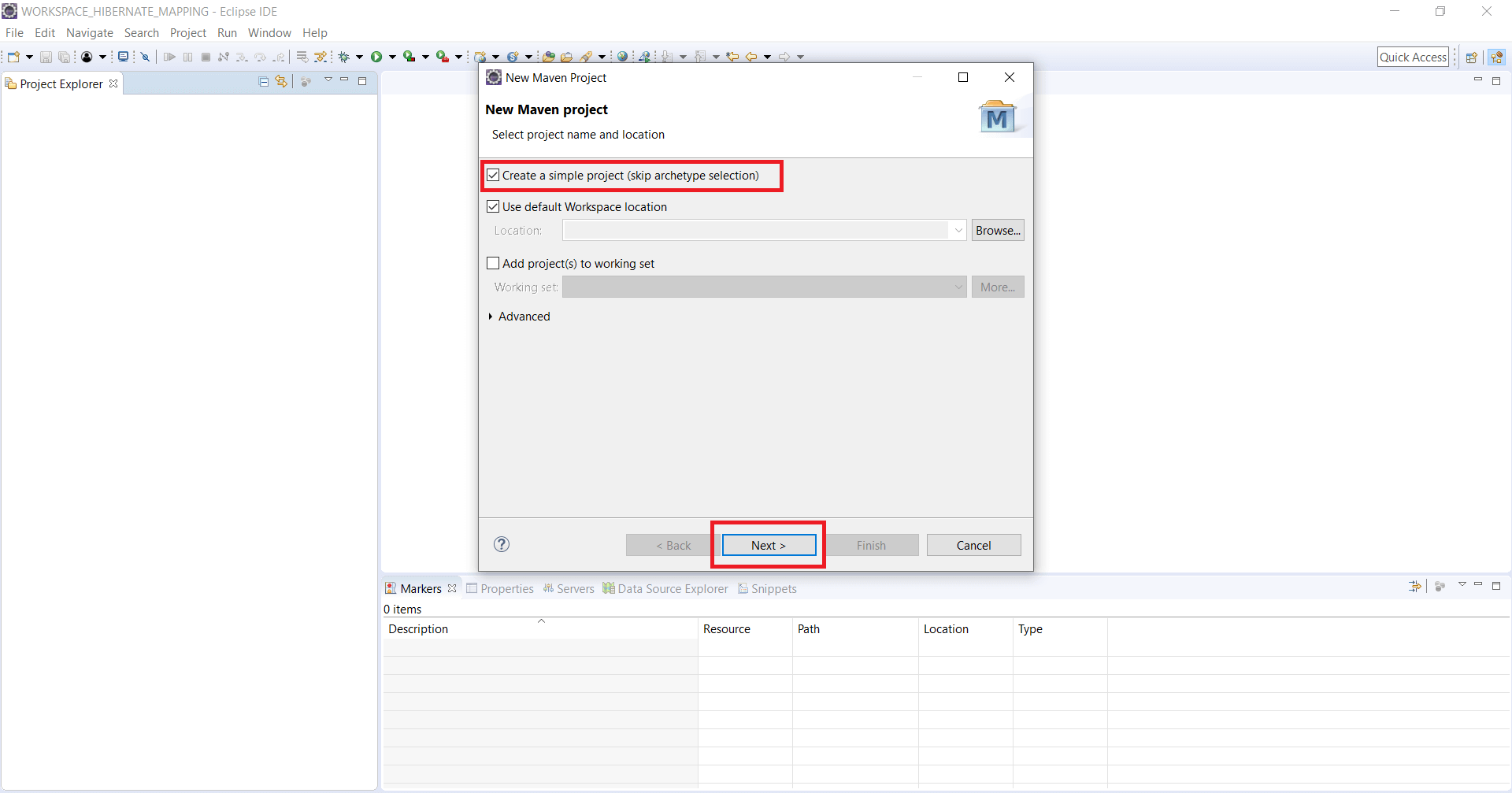
Step 3: Enter Group Id, Artifact Id, Version, Packaging, Name, Description details and click on Finish button.
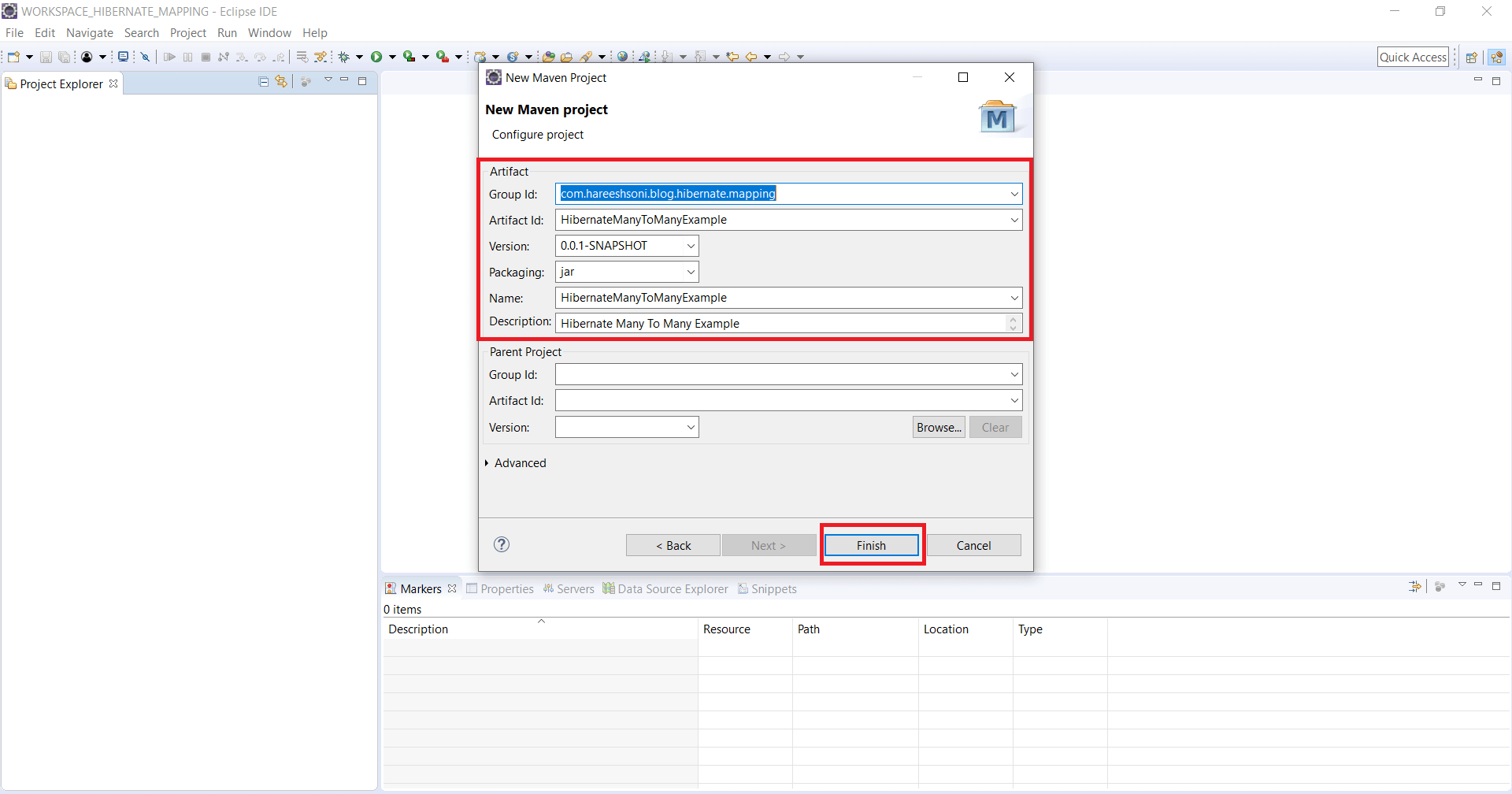
Update pom.xml file.
Open pom.xml file and paste below pom.xml file code.
<project xmlns="http://maven.apache.org/POM/4.0.0" xmlns:xsi="http://www.w3.org/2001/XMLSchema-instance" xsi:schemaLocation="http://maven.apache.org/POM/4.0.0 http://maven.apache.org/xsd/maven-4.0.0.xsd"> <modelVersion>4.0.0</modelVersion> <groupId>com.hareeshsoni.blog.hibernate.mapping</groupId> <artifactId>HibernateManyToManyExample</artifactId> <version>0.0.1-SNAPSHOT</version> <name>HibernateManyToManyExample</name> <description>Hibernate Many To Many Example</description> <dependencies> <!-- https://mvnrepository.com/artifact/org.hibernate/hibernate-core --> <dependency> <groupId>org.hibernate</groupId> <artifactId>hibernate-core</artifactId> <version>5.5.7.Final</version> </dependency> <!-- https://mvnrepository.com/artifact/mysql/mysql-connector-java --> <dependency> <groupId>mysql</groupId> <artifactId>mysql-connector-java</artifactId> <version>8.0.23</version> </dependency> </dependencies> <build> <finalName></finalName> <plugins> <plugin> <groupId>org.apache.maven.plugins</groupId> <artifactId>maven-compiler-plugin</artifactId> <version>3.6.1</version> <configuration> <source>1.8</source> <target>1.8</target> </configuration> </plugin> </plugins> </build> </project>
Update Maven Project
Step 1: Right-click on project HibernateManyToManyExample --> Maven --> Update Project…

Step 2: Check Checkbox Force Update of Snapshots/Releases. Click on OK Button.


We have used the below JPA Annotations:
@Entity: @Entity annotation specifies that the class is an entity.
@Table: @Table annotation specifies the primary table for the annotated entity.
@Id: @Id annotation marks the particular field as the primary key of the Entity.
@GeneratedValue: This annotation is used to specify how the primary key should be generated.
@Column: This annotation maps the corresponding fields to their respective columns in the database table.
@JoinColumn: This annotation defines the foreign key. It is the column that associates the two tables.
@ManyToMany: This annotation is used to create many to many relationship between Person and Hobby entities.
@JoinTable: This annotation is used to define the join table (link table) for many-to-many relationship.
package com.hareeshsoni.blog.hibernate.mapping.model;
import java.util.HashSet;
import java.util.Set;
import javax.persistence.Column;
import javax.persistence.Entity;
import javax.persistence.GeneratedValue;
import javax.persistence.GenerationType;
import javax.persistence.Id;
import javax.persistence.ManyToMany;
import javax.persistence.Table;
@Entity
@Table(name = "hobby")
public class Hobby {
@Id
@GeneratedValue(strategy = GenerationType.IDENTITY)
@Column(name = "hobby_id")
private int hobbyId;
@Column(name = "hobby_name")
private String hobbyName;
@ManyToMany(mappedBy = "hobbies")
private Set persons = new HashSet();
public Hobby() {
}
public Hobby(String hobbyName) {
this.hobbyName = hobbyName;
}
public int getHobbyId() {
return hobbyId;
}
public void setHobbyId(int hobbyId) {
this.hobbyId = hobbyId;
}
public String getHobbyName() {
return hobbyName;
}
public void setHobbyName(String hobbyName) {
this.hobbyName = hobbyName;
}
public Set getPersons() {
return persons;
}
public void setPersons(Set persons) {
this.persons = persons;
}
}
package com.hareeshsoni.blog.hibernate.mapping.model;
import java.util.HashSet;
import java.util.Set;
import javax.persistence.CascadeType;
import javax.persistence.Column;
import javax.persistence.Entity;
import javax.persistence.GeneratedValue;
import javax.persistence.GenerationType;
import javax.persistence.Id;
import javax.persistence.JoinColumn;
import javax.persistence.JoinTable;
import javax.persistence.ManyToMany;
import javax.persistence.Table;
@Entity
@Table(name = "person")
public class Person {
@Id
@GeneratedValue(strategy = GenerationType.IDENTITY)
@Column(name = "person_id")
private int personId;
@Column(name = "person_name")
private String personName;
@ManyToMany(cascade = { CascadeType.ALL })
@JoinTable(name = "person_hobby", joinColumns = { @JoinColumn(name = "person_id") }, inverseJoinColumns = {
@JoinColumn(name = "hobby_id") })
private Set hobbies = new HashSet();
public Person() {
}
public Person(String personName) {
this.personName = personName;
}
public int getPersonId() {
return personId;
}
public void setPersonId(int personId) {
this.personId = personId;
}
public String getPersonName() {
return personName;
}
public void setPersonName(String personName) {
this.personName = personName;
}
public Set getHobbies() {
return hobbies;
}
public void setHobbies(Set hobbies) {
this.hobbies = hobbies;
}
}
package com.hareeshsoni.blog.hibernate.mapping.util;
import org.hibernate.SessionFactory;
import org.hibernate.cfg.Configuration;
public class HibernateUtil {
private static SessionFactory sessionFactory;
private static SessionFactory buildSessionFactory() {
Configuration configuration = new Configuration();
configuration.configure("hibernate.cfg.xml");
System.out.println("Hibernate configuration file loaded");
SessionFactory sessionFactory = configuration.buildSessionFactory();
return sessionFactory;
}
public static SessionFactory getSessionFactory() {
if(sessionFactory == null)
sessionFactory = buildSessionFactory();
return sessionFactory;
}
}
In hibernate.cfg.xml file provide correct username and password.
Create database name "many_to_many_mapping" inside mysql database.
<?xml version='1.0' encoding='utf-8'?> <!DOCTYPE hibernate-configuration PUBLIC "-//Hibernate/Hibernate Configuration DTD 3.0//EN" "http://www.hibernate.org/dtd/hibernate-configuration-3.0.dtd"> <hibernate-configuration> <session-factory> <!-- Database connection settings --> <property name="hibernate.connection.driver_class">com.mysql.cj.jdbc.Driver</property> <property name="hibernate.connection.url">jdbc:mysql://localhost:3306/many_to_many_mapping</property> <property name="hibernate.connection.username">root</property> <property name="hibernate.connection.password">########</property> <property name="hibernate.dialect">org.hibernate.dialect.MySQL5Dialect</property> <property name="show_sql">true</property> <property name="hbm2ddl.auto">update</property> <mapping class="com.hareeshsoni.blog.hibernate.mapping.model.Person" /> <mapping class="com.hareeshsoni.blog.hibernate.mapping.model.Hobby" /> </session-factory> </hibernate-configuration>
package com.hareeshsoni.blog.hibernate.mapping;
import org.hibernate.Session;
import org.hibernate.SessionFactory;
import com.hareeshsoni.blog.hibernate.mapping.model.Hobby;
import com.hareeshsoni.blog.hibernate.mapping.model.Person;
import com.hareeshsoni.blog.hibernate.mapping.util.HibernateUtil;
public class MainApp {
public static void main(String[] args) {
SessionFactory sessionFactory = HibernateUtil.getSessionFactory();
Session session = sessionFactory.openSession();
session.beginTransaction();
Person person1 = new Person("Mohan");
Person person2 = new Person("Sohan");
Hobby hobby1 = new Hobby("Reading");
Hobby hobby2 = new Hobby("Painting");
person1.getHobbies().add(hobby1);
person1.getHobbies().add(hobby2);
person2.getHobbies().add(hobby2);
session.save(person1);
session.save(person2);
session.getTransaction().commit();
session.close();
sessionFactory.close();
}
}
Now run MainApp.java
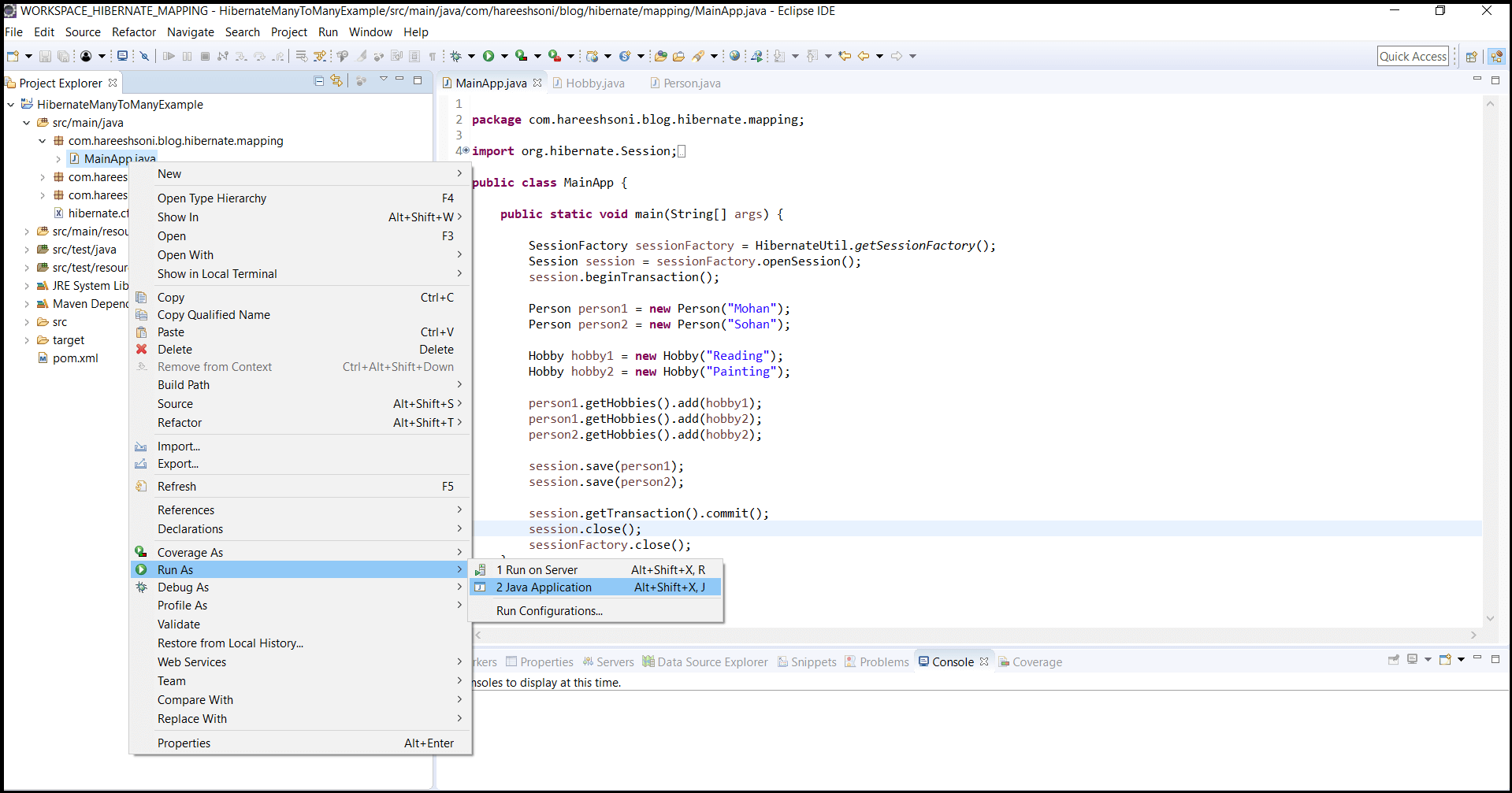
Output
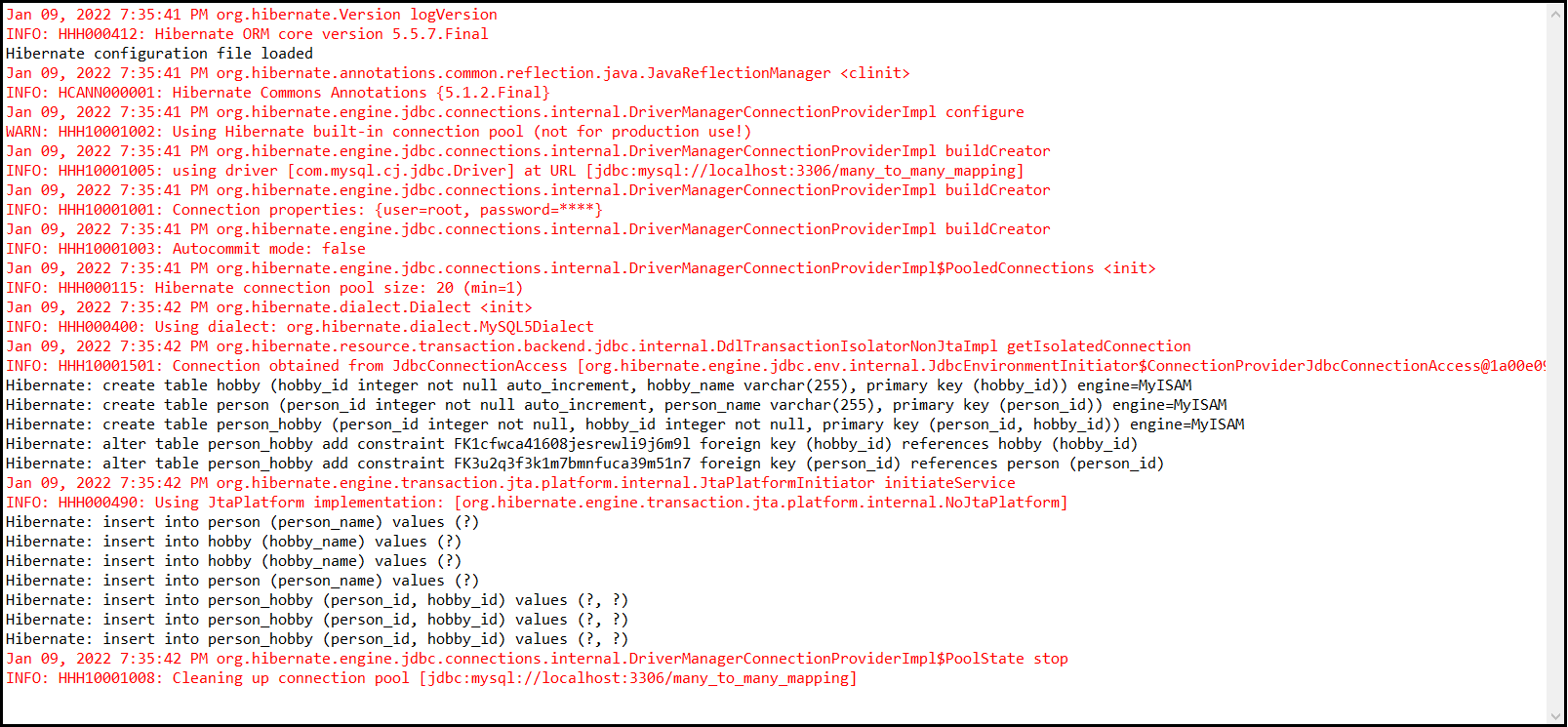
Database tables:
Person Table

Hobby Table

Person-Hobby Table
